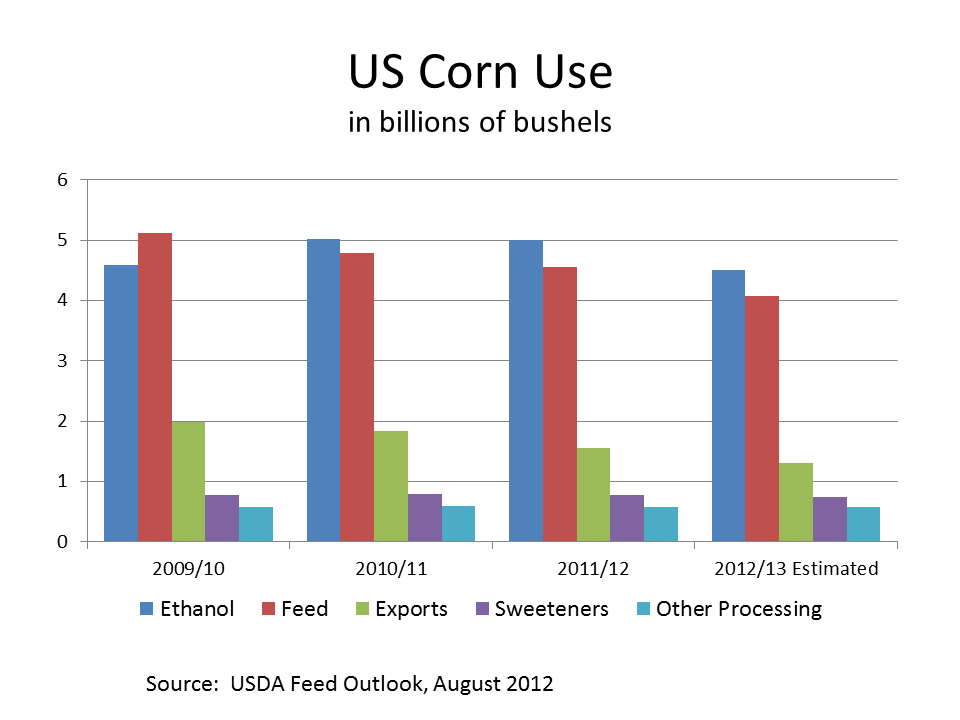Fallout from the US drought
FOOD VERSUS FUEL DEBATE REVIVED
optimists point out that even with a drought-induced 13% drop in yields, the United States is projected to harvest 10.8 billion bushels (bbu) of corn this year – a crop that would have set a record just nine years ago. Everyone else counters that this won’t be enough to meet demand, especially since the US is going into harvest with carryover corn stocks of barely one bbu.
Estimates from the US Department of Agriculture (USDA) suggest corn usage will decline from nearly 13.1 bbu in 2010/11 to less than 11.5 bbu in 2012/13. The question is: where will the cuts come from?
A resolution will likely involve a heated debate between the various sectors involved as supplies become tighter.
US livestock producers, taking a beating from drought-devastated pastures and hay crops, are culling cattle – in the West and Southwest, this is the second year of severe drought and a second round of culling. The drought may be even tougher on hog and poultry producers; there is little they can substitute into their livestock rations to replace corn and soybeans. Not surprisingly, livestock interests are calling for an easing of the US laws that promote the use of corn for ethanol.
The export sector is quieter, but corn export volumes, already at a 12-year low, are dropping further. Some major purchasers, like Japan, regularly use futures markets to lock in pricing. That will give them an initial buffer from escalating corn prices, but other markets, particularly in more economically vulnerable economies like Central America, are much less likely to have that advantage. High corn prices will hit them hard at the same time shipping costs may increase because of the drought’s effect on water levels along the Mississippi River.
GRAPH: US CORN USE, IN BILLIONS OF BUSHELS.

food vs fuel
Rising food prices in the US and other parts of the world are likely to trigger another round of the “food versus fuel” debate. The corn industry’s response in recent years has been to supply enough corn for food and fuel – an answer that won’t satisfy critics this year.
The story for corn processors is more complicated. Many companies, like the big Japanese buyers, lock in futures prices, and most processors will also benefit from a jump in prices for their feed products (corn gluten feed, corn gluten meal, and distillers dried grains). Some ethanol companies will also be better off because their grower members have long-term commitments to supply corn.
The industry’s markets also vary greatly. Products typically used at low levels, in long-established processed goods, can withstand higher corn prices better because the effect on per unit costs is so low. As an example, the corn sweeteners in a typical candy bar may cost only a penny or two.
As a result, high prices are expected to leave corn use in glucose syrups, dextrose, and beverage alcohol production unchanged, and use in dry milled products like cereals may even increase. Starch and high fructose corn syrup (HFCS) use are projected to decline modestly (15 million bushels for starch, 30 mbu for HFCS).
Ethanol is another story which is complicated further by the effect of oil prices on US driving habits and on ethanol’s relative profitability. There is already evidence of scaled-back production, and weaker companies could face closures. The USDA’s August report estimates a 500 mbu drop in corn use for ethanol.
Added up, the USDA’s projection for corn use shows an 8% decline in processing, a 10% drop in livestock feeding, and a 16% drop in exports. Those cuts are likely to be achieved through grain market functions. Ever since a US embargo on grain exports to Russia in 1980, US agriculture has been vehemently opposed to any suggestion of government meddling in who gets the grain – making a Russian-style embargo unfavourable, especially in an election year. Instead, the USDA is likely to continue with drought aid measures such as its already-announced purchase of meat for food aid and the lifting of grazing restrictions on conservation reserve land.
what about soybeans and wheat?
For 2012/13, the USDA projects a decline of 175 mbu in soybean crush to a 16-year low and a 240 mbu decline in bean exports to a seven-year low. That could push China, which buys more than half of all US exports, into looking for additional supplies.
US 2012 wheat production was down just 157 mbu (7%) from the five-year average, and reserves coming into 2012 were at 862 mbu, well above the five-year average of 593 mbu. The USDA projects increased wheat use for food, livestock feed, and exports in 2012/13. •







